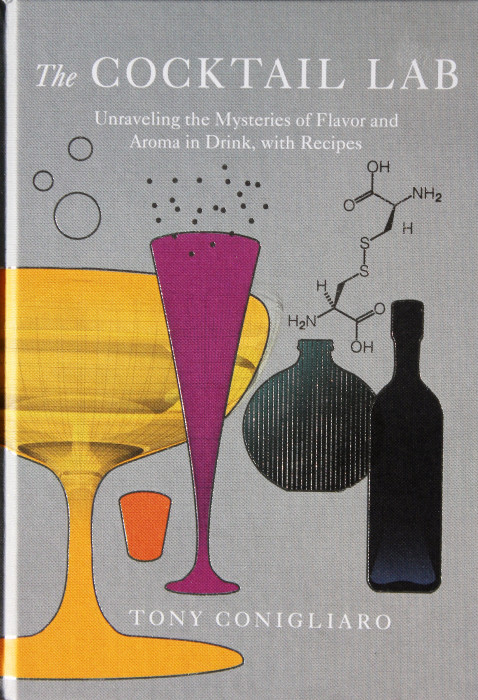Post art school in London, Tony Conigliaro needed to fund his life and his painting supplies. He added flavor to art, expanding his life into the bar industry and changing our drinking lives. He is a famed master mixologist and this award winning book does three things for us. First, it supplies 60 superior beverage recipes. Second, it explains to us the complex chemical and biological aspects of tasting and relishing beverages. Lastly, it shows us how incredibly complex can be the creation of outrageous new flavors.
We don’t chew cocktails. We let the alcohol waft and carry sensations up the back of our throat into our complex olfactory chamber. Our drinking experience is really one of molecules meeting molecules and triggering electrical signals to our big brains. We can only thank God that this is achieved through evolution and not twelve years of grade and high school. Although, in high school, …
I digress.
Tony explains that his success stems from understanding flavor and how to manipulate it. To do that, he examines the components of a drink and how they combine. He explains that you can try, or must try, a Dry Martini twenty or thirty ways and then, and really only then, begin to understand the craft of beverage construction. At his Drink Factory consultancy, Tony will experiment hundreds to times to achieve, if not perfection, then surely a combination that is heads-and-tails superior.
Tony’s lab is really that. A lab with exotic equipment that lets him mix, foam, and control temperatures in ways that you and I cannot do at home. His science knowledge is presented in this book in its full complexity along with some home friendly recipes that mortals can tackle. And cocktails are not all food science. There is history, mythology, and surely romance behind cocktails and Tony appreciates all those aspects of our drinking lives.
Tony’s perspective on cocktails is immense. This book is not your standard cocktail book or just a simple bar manual. This is a book of ideas, ones to educate you, and to inspire you. We live in a new cocktail age with grand mixologists everywhere you turn and beverage sites bounding over the web. It can all be dazzling and confusing. The Cocktail Lab is your guide to getting a calm understanding of what the devil is going on. Why does this Bloody Mary taste so good? Tony can explain.
The book has seventeen chapters, ranging from Classics & Spins to Glassware. Along the way, you learn about using savory components, perfuming your cocktail, employing juices and potent cordials, adding foam, and exploiting macerations. All the “new” fashions are here and explained.
Classics & Spins, the first chapter, is a graceful introduction to Tony’s style: understand the basics, test and experiment, then perfect. For example, he starts with a classic Sgroppino: vodka, lemon ice cream and champagne or Prosecco. In Tony’s version, the Elegante, there is fresh lemon juice, sugar syrup, lemon sorbet instead of ice cream, and crushed ice to achieve a deeper level of chill. His spin adjusts the classic, and the result is for you to judge. You’d probably pick Tony’s.
His margarita uses broiled lemon juice, his mojito has apple juice. Tony offers a Fig and Licorice Caipirinha, something that has come from London and not Brazil.
His Bloody Mary is a work of art: homemade horseradish vodka, lemon juice, Worcestershire sauce, celery salt, pepper tincture, hot pepper sauce, and homemade tomato mix. It’s the same “Bloody Mary” name but so very specialized. To learn about making that horseradish vodka or the pepper tincture or the pepper sauce or his very different tomato mix, you do need your own copy of The Cocktail Lab. The value of this book lies not just in the drink recipes but in the guide to creating all these clever components.
Will that Bloody Mary take some time? Yes. Will it pay off? Oh, yes.
To achieve a perfume flavor, used in the Blush, Tony has you make rose vodka. Using his science lab, and there is no other way to describe it, his Chamomile Cooler uses Chamomile foam. There’s a recipe for the foam, but you’ll need some N20, and gomme syrup and chamomile powder. Some of Tony’s recipes are more for reading and pondering, not necessarily assembling at home.
Tony devotes a chapter to that gear in his cocktail lab space: a vacuum machine, centrifuge, soxhlet still, Buchner funnel with vacuum pump, microjuicer, induction heat, smoke gun, separatory funnel, micropipette, refractometer, brix meter, rotavapor, and peristaltic pump. Most of us are not going that far, but I do appreciate knowing the definition of “dedicated.”
There is a fun little chapter on homemade cordials and may inspire you to try these ideas or fashion your own. Recipes are here for lime, gooseberry, rhubarb, elderflower, and even nettle — just 8 grams of nettles with 1 pound of sugar and 5 cups of water, so the sting should be mild.
There are recipes for homemade liqueurs and syrups including Rhubarb Liqueur and Salted Caramel Liqueur. Imagine Salted Caramel on the rocks while eating a salted caramel brownie!
Tony indicates that this is an unusual book. There are things here, like hot pepper sauce, that have so many ingredients and pieces of equipment and steps that I’m just overwhelmed. I leave some things to the professionals. Brain surgery and his hot pepper sauce are off the table for me. But I can make rose vodka and combine it with raspberry syrup and champagne to craft a Lipstick Rose. There are plenty of ideas in The Cocktail Lab that do not require an industrial science lab. And all those ideas are ones you can sip away in confidence and gratitude to master mixologist Tony Conigliaro.
